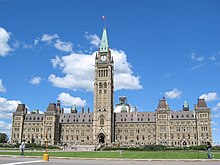Navigable Waters Protection Act
| Navigation Protection Act | |
|---|---|
 |
|
| Citation | R.S.C., 1985, c. N-22 |
| Enacted by | Parliament of Canada |
| Date assented to | 17 May 1882 |
| Amendments | |
| R.S.C. 1985, c. 1 (2nd Supp.); S.C. 1993, c. 41; 1997, c. 10; 2004, c. 15; 2009, c. 2; 2012, c. 31 | |
The Navigation Protection Act (formerly the Navigable Waters Protection Act) is one of the oldest regulatory statutes enacted by the Parliament of Canada. It requires approval for any works that may affect navigation on navigable waters in Canada.
Following the decision of the Judicial Committee of the Privy Council in McLaren v. Caldwell, the Parliament asserted its jurisdiction by enacting "An Act respecting Bridges over the navigable waters, constructed under the authority of Provincial Acts", which received royal assent on 17 May 1882. Originally extending only to the construction of bridges, its scope was enlarged in 1883 to cover bridges, booms, dams and causeways, and in 1886 to cover wharves, docks, piers and other structures. With the publication of the Revised Statutes of Canada, 1886, it became known as "An Act respecting certain works constructed in or over Navigable Waters."
From 1882 to 1966, the Navigable Waters Protection Act was administered by the Department of Public Works.
By 2002 The Navigable Waters Protection Act (NWPA) was described as a "federal statute designed to protect the public’s right to navigation and marine safety in the navigable waters of Canada." The Act was "administered by the Navigable Waters Protection Program (NWPP) under the Canadian Coast Guard (CCG) of the Department of Fisheries and Oceans.
In 2004, authority for the Navigable Waters Protection Act was transferred to Transport Canada.
The Canadian Coast Guard (CCG) may also be consulted regarding navigation issues.
Works that affect navigation are subject to federal approval under the NWPA, which is generally coordinated with corresponding provincial approvals (as the beds of navigable waters are generally reserved to the Crown in right of the province)
The Act is relatively silent about the complete definition, saying only that a “navigable water” includes "a canal and any other body of water created or altered as a result of the construction of any work." The Supreme Court of Canada, however, adopted the "floating canoe" threshold in 1906, holding that any water that was navigable and floatable was within its scope.
...
Wikipedia
